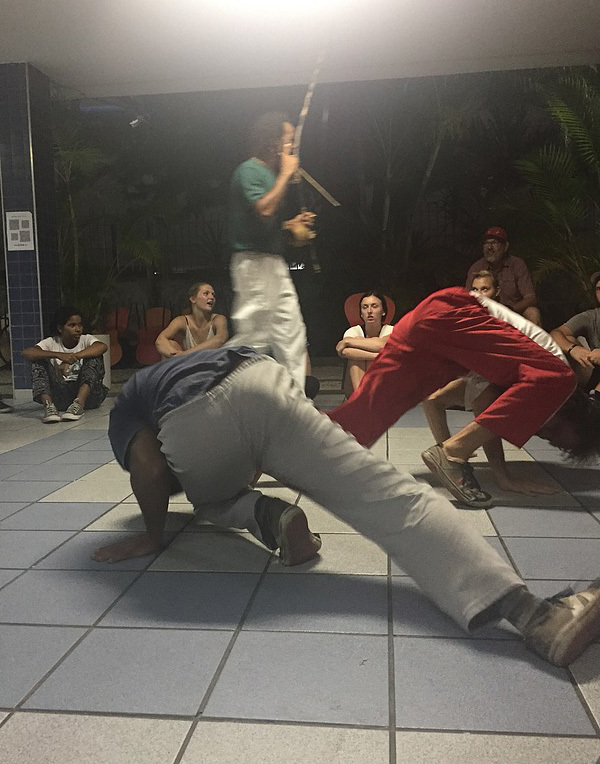Oi! My name is and I'm from St. Louis Park, Minnesota. I'm a senior studying political science and French.
Today was packed with activities- starting off with a samba class with an instructor whom we presumed was a little over 30 years old but in reality was in his 50s! Samba knows no age! Personally, I was a little hesitant for the session since I have two left feet and the extent of my dance experience was playing Dance Dance Revolution in middle school. The class started off with the instructor explaining samba's background and explained how the African people that were brought over as slaves to Bahia (the Brazilian state in which Salvador is in) could not bring anything tangible with them. Thus, what they had were in their head and in their hearts- their history and culture. Samba can act physical manifestation of this culture through the utilization of the body by creating movement and music via clapping, singing, stomping, etc. We explored making music with our hands and feet, and basic samba moves with steps and arm motions. I was pretty impressed how quickly everyone picked up the moves! The instructor emphasized that samba involves letting go of inhibition and taking in the dance experience without sight alone. The sense required to feel samba is a synchronization of the mind and body. Dancing is already a foreign concept as a Lutheran, but letting go of inhibition and actually enjoying yourself? That's a tall order. But I think I can speak for everyone when I say it was a marvelous experience, and I may take off my shoes and start samba-ing down Water Street in the near future.
We enjoyed lunch at a "per kilo" restaurant (essentially a buffet) and geared up for a lecture by Lisa Earl Castillo. She discussed the religion of Candomblé in Bahia and its development and historical context. This religion had a number of temples, as freed slaves pooled their means together to create them (Castillo p. 12).
Something that struck me during her presentation was the Yoruba language, which is native to Benin, and is where many slaves had called home. Although it is no longer spoken here in Bahia in normal conversation, it is utilized in a ritual context. Yoruba is still spoken in some African countries.
We had a quick bite to eat at a bakery, and we all enjoyed slices of cake and other goodies. I asked if they had a cookbook, and although they did not, I was given a tip about how to make cakes taste as good as the ones we'd just eaten. They said, "add sweetened condensed milk to everything". Duly noted!
Our last activity for the evening involved burning off all the calories we'd just consumed in a capoeira class. Capoeria, developed by slaves, is "an extraordinary physical discipline, combining martial arts, dance, and rhythms" (Gates p. 24). It is a combination of both fighting for the sake of self-defense and dance practiced by slaves who were both unarmed and endlessly subject to torture and abuse by slave owners. Because slaves could not outright practice these self-defense moves openly, they "disguised their regiment as a kind of ceremonial, even celebratory, dancing, consisting of well-coordinated and syncopated, almost balletic movements and movements characteristic of martial arts" (p. 25). Like samba, capoeira is a manifestation of culture created by slaves who had to leave all tangible remnants of culture and home behind.
I'd not heard of it prior to this course and was excited to see it in action. The instructor explained the history behind capoeira, the uncertainty over where it originated, why is was practiced, and different types. The style he taught us was Capoeira Angola, which originates from the fact that many slaves came from Angola. We all practiced fundamental moves of Capoeira Angola, played music, and watched more experienced players play. The music involved vocals, tambourines, African instruments, and my personal favorite which is the berimbaus. It looks like a bow and arrow and sounds kind of like a sitar. You'll have to Google this one, that's the best I can describe it!
Needless to say, we got our intellectual and physical workout for the day! That's all for today, but we have a busy next few days coming up so be sure to stay tuned! Thanks for reading and boa noite from Salvador da Bahia, Brazil!
- Castillo, Lisa Earl. "Icons of Memory: Photography and Its Uses in Bahian Candomblé." Stockholm Review of Latin American Studies 4 (2009).
- Gates, Henry L. Black in Latin America. New York: New York. University Press, 2011. 12-58.






